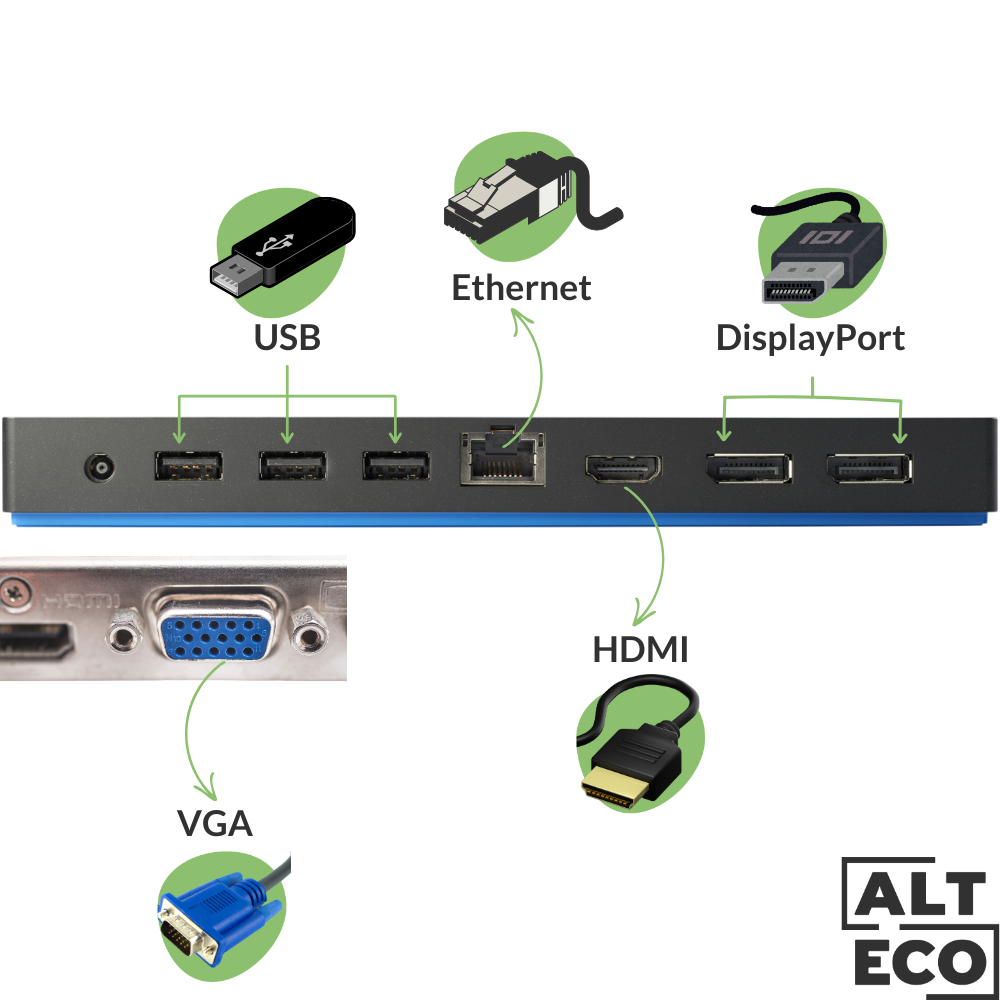User Guide For Windows Computers
Summary
Thank you from Alt Eco.
Your purchase has saved around 76% CO2 compared with an equivalent new device.
Thank you for choosing Alt Eco for your purchase. Alt Eco is a company specialized in the refurbishment of computer devices since 2014. We are committed to providing high-quality products through a circular, sustainable, and viable economy. You will find in this guide general help and advice on the use and maintenance of your products.
After-sales service: If you have consulted this manual and still haven’t found the answer to your question, our after-sales service team will be delighted to assist you.
Please follow this link: https://www.alt-eco.fr/sav
 Preliminary safety information
Preliminary safety information
Do not expose the device to extreme temperatures (-20 to +45°) or water.
Do not attempt to disassemble the device yourself.
Use only the accessories provided or recommended by the manufacturer
Getting started with the product and operating system: tips and usage for Windows 10 & 11
First boot
Windows 10 & Windows 11
- To switch on your device, press the power button. Check that the AC adapter is connected to the power port (usually circular or USB-C) for charging the laptop battery.
- When you start up your device for the first time, the Setup Wizard guides you through the configuration process.
- If your Windows laptop doesn’t start up, plug in the AC adapter to charge the battery and try again.
- To migrate from Windows 10 to Windows 11, follow this link: Windows 11 upgrade
To setup a computer running Windows 10: Windows 10 Configuration Guide
Basic use
Here are several tips for former Windows users: https://www.microsoft.com/fr-fr/windows/tips-and-tricks?r=1
- The desktop is the screen you see when you log on to Windows. Here you can store files, folders and application shortcuts.
- It’s customizable: you can change the theme and background by right-clicking on the screen.

Your computer has several folders from its launch (available in quick access in File Explorer):
- Documents: this is where you can store and organize your personal documents.
- Downloads: this is where the files you download from the Internet are usually saved.
- Images: you can store your photos and images here.
- Music and videos: these folders are intended to store your multimedia files.

Regarding the applications:
- Microsoft Edge: it is the default web browser of Windows.
- Microsoft Office: it is a productivity application suite that includes Word, Excel, PowerPoint, and others.
- Windows Store: you can download applications and games from the Windows Store.
- Settings: you can customize your Windows PC in the Settings.

Keyboard shortcuts

Copy: Ctrl + C
Cut: Ctrl+X
Paste: Ctrl + V
Enlarge window: F11 or Windows (key circled in red in image) + Up arrow
Open task view: Windows + Tab
Show and hide desktop: Windows key + D
Toggle between open applications : Alt + Tab
Open Quick Link menu: Windows key l+ X
Lock PC: Windows logo key + L
Depending on your keyboard, you can use the Windows key + Screenshot to take a screenshot, or use Fn + Windows key + Space.
Connectivity

Windows Laptops
Windows laptops typically feature USB-A and USB-C ports. You can use these ports to connect your device to other peripherals such as a mouse, keyboard, phone, etc.
You might need an adapter to connect SD cards, Ethernet cables, and certain devices that do not have a USB-C port.
These ports are also used to charge your laptop.
Your Windows laptop usually has an audio output that allows you to plug in your earphones, headphones, and other audio output devices with a 3.5 mm audio jack.
Windows Desktop PCs (e.g., Towers)
Windows desktop PCs are generally equipped with multiple USB-A and USB-C ports, HDMI, DisplayPort, or Ethernet (RJ45) ports located at the back or sometimes at the front of the tower. You can use these ports to connect your device to other peripherals.
They also have Ethernet ports for wired internet connections, as well as slots for SD cards or other types of memory cards.
Windows desktop PCs also feature audio outputs to connect speakers, headphones, or other audio devices.
Some models may also offer remote connectivity features, such as Remote Desktop.
Updates
Updates provide security patches and new features from Microsoft for Windows 10 and 11, as well as for integrated applications. Many software issues can be resolved by updating your system. Updates also help maintain maximum security on your devices.
Before updating, it is advisable to back up your PC’s data, keep your device plugged in, and ensure it is connected to the Internet.
For Windows 10 and 11, you can check for updates by following these steps:
- Select the Start button, then click on Settings.
- Click on Update & Security.
- Select Check for updates to see if your PC can run Windows 11, or if the upgrade is ready for your PC.
More details regarding updates and compatible devices are available at this link: Microsoft Support
Security and Health
- Ensure that your Windows operating system is always up to date. Updates often contain security patches and performance improvements.
- Use reliable antivirus software and keep it updated. Windows Defender, which is integrated into Windows 10 and Windows 11, offers real-time protection against malware.
Understand the Specific Absorption Rate (SAR)
The Specific Absorption Rate (SAR) is a measure of the rate at which the human body absorbs radiofrequency (RF) energy from devices such as mobile phones, tablets, and other wireless communication equipment. It is expressed in watts per kilogram (W/kg). The SAR value indicates how much RF energy is absorbed by the body when using a wireless device. Regulatory agencies worldwide, including the Federal Communications Commission (FCC) in the United States and the International Commission on Non-Ionizing Radiation Protection (ICNIRP) in Europe, have set safety limits for SAR values to ensure that devices are safe for consumer use.
To minimize exposure to RF energy, consider the following precautionary measures:
- Use Hands-Free Devices: Utilize hands-free options such as speakerphone, wired headphones, or Bluetooth headsets to keep the device away from your head and body.
- Limit Device Use: Reduce the duration of calls and the amount of time spent using wireless devices.
- Keep Distance: Hold the device away from your body when not in use and avoid keeping it in your pocket or close to your skin.
- Text Instead of Call: Send text messages instead of making voice calls when possible.
- Use Airplane Mode: When the device is not needed for communication, use airplane mode to disable wireless transmissions.
- Optimize Signal Strength: Use the device in areas with good reception, as lower signal strength can increase RF exposure.
Potential dangers
While scientific studies have not conclusively proven that RF energy from wireless devices causes adverse health effects, there are potential risks associated with long-term exposure:
- Thermal Effects: RF energy can cause heating of body tissues, leading to thermal effects. High SAR values can result in significant tissue heating, potentially causing burns or heat-related injuries.
- Non-Thermal Effects: Some studies suggest that long-term exposure to low levels of RF energy may lead to non-thermal biological effects, such as changes in cell function or stress responses, though these findings are still under investigation.
- Increased Risk for Certain Groups: Children, pregnant women, and individuals with certain health conditions may be more susceptible to RF energy exposure. Extra caution is recommended for these groups.
SAR values and regulatory limits

To ensure consumer safety, devices must comply with the SAR limits set by regulatory agencies. For example:
- United States (FCC): The SAR limit for mobile devices is 1.6 W/kg, averaged over 1 gram of tissue.
- Europe (ICNIRP): The SAR limit is 2.0 W/kg, averaged over 10 grams of tissue.
Manufacturers are required to test their devices and provide SAR information to demonstrate compliance with these safety standards.
These tips are general and may vary depending on the specific version you own. For more detailed instructions, please visit the manufacturer’s website or refer to the specific user guide for your device, available on the manufacturer’s site and/or platform.
Best Practices
To reduce your environmental footprint and extend the lifespan of your product in the spirit of sustainability, please follow these practices.
- Keep the device clean and away from dust and heat sources to avoid overheating problems.
- Recycle your old devices responsibly.
- It is strongly recommended to select the Optimized battery mode and keep the power adapter permanently connected. This mode will allow the battery to be fully charged to 80% or 60% of its nominal capacity.
- Remove all media from drives and turn off all connected devices and the computer. Then, unplug all power sources, such as batteries or power cords, from outlets and unplug all cables connected to the computer.
- Make sure your computer is well ventilated, and avoid placing it on surfaces that obstruct the fans. Overheating can damage your computer’s internal components.
Environment: In an era of ever-increasing digital and atmospheric pollution, Alt Eco is committed to sustainable and ethical consumption through its products and processes.
- Regularly empty your mailbox. Sort through your emails to save cloud storage space and reduce environmental impact.
- Mindful of the potential environmental impact of our products (batteries and chargers), we aim to raise awareness about the collection systems of e-waste (electronic waste). When your laptop battery or phone charger reaches the end of its useful life, you have several options:
- Use the selective collection system in your municipality (waste disposal site, local collection).
- Return your old device when purchasing a new one (1 for 1 take-back by the distributor).
- Replace the battery at the manufacturer or with a repairer recognized by the brand.
Maintenance and Durability
Battery: Rechargeable lithium-ion/lithium-polymer batteries have a limited lifespan and will gradually lose their ability to hold as much charge as the original design capacity. This aging, or loss of capacity, is irreversible. As the battery loses its capacity, the length of time it will power the product (i.e., the operating time) decreases. Battery life varies depending on how and where the system is used. Here are some tips to maximize your battery life:
- Turn off the device when you are not using it to save energy. Always lock your device when you are not using it and set up an automatic lock after a few minutes of inactivity.
- Reduce the brightness level of the screen. The screen is one of the biggest consumers of battery energy. Save a lot on battery life by reducing the brightness level to the lowest and comfortable level.
- Unplug unnecessary devices. To save battery, remove other devices like phones or headphones that are charging. When you are not using the laptop, but a power source is needed, prefer a power adapter on a wall outlet.
- Disable Bluetooth and/or Wi-Fi. If you are not using this feature, disable it to avoid draining the laptop’s battery.
- Stop or put the laptop in rest mode rather than using it in standby mode, if it is not planned to be used for a certain time. Standby continues to consume energy so that the laptop is ready to operate when the lid is opened. Depending on the settings and the operating system, some applications may continue to run in standby.
- Leaving your computer plugged in all the time causes the battery to heat up and lose energy. As a result, your battery may charge less efficiently and be damaged more quickly.
- Choose a daily charge of a few tens of minutes.
Here are some tips on the cables supplied:
- Laptop chargers can be delicate.To extend their lifespan, it is crucial to handle them with care and avoid certain practices that could cause damage.
- In the market or online, inexpensive chargers may appear appealing, but they tend to have a shorter lifespan than equipment purchased from an official retailer. These chargers may have manufacturing defects that reduce their longevity. They are more prone to overheating and provide less power than official chargers. As a result, charging may take longer. Moreover, these devices may end up costing more in the long run as you will need to replace them more frequently.
- It is advisable to avoid winding the charging cable too tightly, as this can damage the cable and shorten its lifespan. Finally, avoid leaving it loose in your bag and carrying it everywhere to prevent excessive handling. Take care of your charger, and it will take care of your computer.
- Avoid pulling on the power cable, and use extension cords if necessary.
Cleaning
Cleaning your computer’s Lid
Clean the exterior of your device occasionally by following these steps:
Power down your PC and disconnect the AC adapter or power cord.
Only use gentle cleaning solutions (ammonia-free and non-abrasive) and a soft, slightly damp, lint-free cloth to clean your PC’s casing. Disinfectant wipes may also be used.
Employ a circular motion while cleaning, taking care to prevent any water from seeping into openings.
- Go over the surface with a dry cloth to remove any remaining liquid residue.
- Wait for the surface to be completely dry, then remove any fibers left by the sponge or cloth.
- Allow the casing to dry thoroughly before closing the laptop.
Cleaning your computer’s keyboard
Clean the exterior of your device occasionally by following these steps:
- Dampen a soft, lint-free cloth with 70% isopropyl alcohol (also called rubbing alcohol).
- Wring out excess liquid from the soft, lint-free cloth.
- Gently rub each key with the cloth. Do not allow water to seep under the keys.
- Let the keyboard dry completely before using your computer.
 Caution: Never use abrasive cleaners or solvents on your computer. They can damage the finish.
Caution: Never use abrasive cleaners or solvents on your computer. They can damage the finish.
Warning: Unplug your charging cable and switch off the computer to avoid damage or short-circuiting.
Cleaning your computer’s LCD screen
 Warning: Never spray or pour liquid cleaner directly onto the LCD screen or keyboard.
Warning: Never spray or pour liquid cleaner directly onto the LCD screen or keyboard.
Turn off your Mac and unplug the power adapter then:
- Use a soft, slightly damp (with water), lint-free cloth to clean the screen.
- Gently rub the screen with the cloth, being careful not to allow water to seep into any openings.
- Let the screen dry completely before closing the MacBook or turning on the iMac.
- Do not use an air compressor. It can compact dust and debris into areas that are potentially hazardous for the optimal functioning of components and cause irreversible damage to the motherboard.
Notes:
- For stubborn stains, you may also use wipes specifically designed for computer screens.
- Be careful to avoid liquid spillage on the computer.
Disinfecting Your Computer, Keyboard, and Screen
Turn off your Mac and unplug the power adapter, then:
- Prepare your cleaning wipes. Hydrogen peroxide or alcohol-based wipes are recommended. Do not use wipes containing sodium hypochlorite (bleach).
- Start by cleaning the lid, then the keyboard, and finally the screen of your Mac. Gently rub each surface with the wipe, being careful not to allow liquid to seep into any openings.
- After the prescribed contact time on the wipe packaging, wipe off the residual solvent as soon as possible. Use a soft, dry, lint-free cloth for this.
- Let your Mac dry completely before turning it on.
Note: Medical wipes and their chemical composition can affect your device. Depending on the chemicals, frequency, and duration of use, medical wipes can impact the aesthetic appearance and functionality of the system. To minimize this risk, always use standard cleaning wipes and follow the provided instructions.
Thank you for choosing Alt Eco for your responsible and ethical computing needs.




